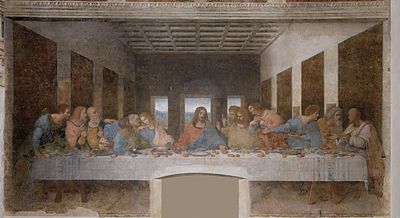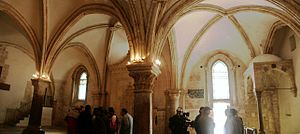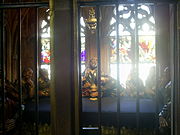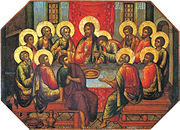
Last Supper
Did you know...
This Wikipedia selection is available offline from SOS Children for distribution in the developing world. Before you decide about sponsoring a child, why not learn about different sponsorship charities first?

|
in the Gospels |
|---|
|
According to Christian belief, The Last Supper is the final meal that Jesus Christ shared with his Twelve Apostles in Jerusalem before his crucifixion. The Last Supper provides the scriptural basis for the ceremony known as "the Eucharist", "communion" or "the Lord's Supper."
Paul's First Epistle to the Corinthians is the earliest surving mention of the Last Supper. It is later described in more detail in the Synoptic Gospels, and in the Gospel of John (which, however, omits the institution of the Eucharistic use of the bread and wine). According to Paul ( 1 Corinthians 11:23–26), at that meal Jesus, on the night he was betrayed, gave his disciples bread, saying it was his body, which was broken for them, and gave them wine, saying it was the new covenant in his blood, and told them to do it in his memory. In the Synoptic Gospels, Jesus institutes a new covenant of his blood and body, the wine and bread, at the Passover meal. The Gospel of John recounts, instead of the institution of this new covenant with wine and bread, Jesus' washing of the disciples' feet, and also depicts Jesus as speaking at length in his farewell discourse. In John, the Last Supper takes place on the night before Passover, when the sacrificial lambs were slaughtered.
Scholars have looked to the Last Supper as the source of early Christian Eucharist traditions. Others see the account of the Last Supper as derived from 1st-century eucharistic practice as described by Paul in the mid-50s.
New Testament
Descriptions of the Last Supper appear in Paul's first letter to the Corinthians, in the Synoptic Gospels, and in the Gospel of John.
Paul's letter to the Corinthians: the earliest description of the Last Supper
The earliest written books of Christian scripture are the letters, or epistles, of Paul, the apostle to the gentiles. In his first letter to the church he had founded in Corinth, usually attributed to Paul's two-year stay in Ephesus (between 53 and 57 AD) Paul described the Last Supper:
| “ | 23For I received from the Lord what I also passed on to you: The Lord Jesus, on the night he was betrayed, took bread, 24and when he had given thanks, he broke it and said, "This is my body, which is for you; do this in remembrance of me." 25In the same way, after supper he took the cup, saying, "This cup is the new covenant in my blood; do this, whenever you drink it, in remembrance of me." For whenever you eat this bread and drink this cup, you proclaim the Lord's death until he comes. | ” |
|
— 1 Corinthians 11:23-26, NIV |
||
Paul states he received this "from the Lord", without specifying whether he received it by a direct revelation, or through intermediaries.
Robert Funk and members of the Jesus Seminar consider the Lord's supper to have derived not from Jesus' last supper with the disciples but rather from the gentile tradition of memorial dinners for the dead. In this view, the Last Supper is a tradition associated mainly with the gentile churches that Paul established, rather than with the earlier, Jewish congregations.
Last Supper in the Synoptic Gospels
All three Synoptic Gospels also recount, in similar words, the same supper. The gospel accounts are more detailed, including the meal's location (an upper room) and Jesus' foreknowledge of his betrayal by Judas. Jesus also tells the disciples that he will not drink wine again until he drinks it in God's Kingdom.
In Mark 14:24 and Matthew 26:28 (in the best manuscripts), Jesus' reference to the "blood of the covenant" echoes Exodus 24:8, suggesting a tradition that understood Jesus' sacrifice in terms of the Mosaic covenant with Israel. In some manuscripts, the word "new" appears in the phrase, so in these manuscripts Jesus refers to the blood of the "new covenant."
Only in Luke does Jesus tell his disciples to repeat the ritual of bread and wine. These particular lines do not appear in certain ancient manuscripts and might not be original to the text.
Last Supper in John
In John, Jesus has his last supper and is executed not on the day Nisan 15 (the first night of Passover) but on Nisan 14, when the Passover lambs were slaughtered. Presumably the author preferred this date because it associated Jesus as the Lamb of God with the sacrificial lambs of Passover.
In its account of the Last Supper, John's Gospel, which does not speak of an institution, with bread and wine, of a new covenant, tells of Jesus washing his disciples' feet before the meal. Martin F. Connell has suggested that some early Christian communities may have used foot-washing as the rite of initiation.
At the meal, according to John, Jesus gave an extended sermon to his disciples. These discourses resemble farewell speeches called testaments, in which a father or religious leader, often on the deathbed, leaves instructions for his children or followers. This sermon is sometimes referred to as the farewell discourse of Jesus, and has historically been considered a source of Christian doctrine, particularly on the subject of Christology. Amongst the canonical Gospels, John is unusual in the complexity of its Christology (which has led to questions about its authenticity), and this sermon portrays one of the most complex Christological descriptions in John. Jesus is presented as explaining the relationship between himself and his followers, and seeking to model this relationship on his own relationship with God.
The account in chapters 14-17 of John includes an extended metaphor of Jesus as the true vine. God is described as the vine tender, and his disciples are said to be branches, which must "abide" in him if they are to "bear fruit". The disciples are warned that barren branches are pruned by the vinedresser. This image has been influential in Christian art and iconography. The disciples are reminded of the love of God for Jesus, and of Jesus for the disciples (especially the beloved disciple), and are then instructed to "love one another" in the same manner. It goes on to speak of the "greatest love" as being the willingness to "lay down" life for one's friends, and this passage has since been widely used to affirm the sacrifice of martyrs and soldiers in war, and is thus often seen on war memorials and graves.
The sermon goes on to talk of Jesus' sending "another paraclete" (Greek: ἄλλο Παράκλητον), a "Spirit of Truth" that will "testify about" Jesus. Paraclete comes from the Koine Greek word παράκλητος (paraklētos, "one who consoles, one who intercedes on our behalf, a comforter or an advocate"). When the dogmatic definition of the Trinity became necessary in the 3rd century, the passage became central to the arguments about the role of the Holy Spirit. Arguments about the Filioque, which partly caused the East-West Schism between the Roman Catholic Church and the Eastern Orthodox Church, centered around this verse. In some sectors of the early Jesus movement the paraclete was considered a more human figure, and, in the 2nd century, Montanus claimed that he himself was this paraclete that had been promised.
Verses 14:30-31 represent a conclusion, and most modern scholars regard the next three chapters to have been inserted later.
Prominent Biblical scholars consider the farewell discourse not to be authentic. Stories about Jesus and his teaching were transmitted orally for decades after his death, and the farewell discourse is too long and prose-like to have been transmitted this way. In addition, it appears only in the gospel of John, which is considered a poor source for historical information about Jesus. Most scholars regard the discourses as having been assembled over time, representing the theology of the "Johannine circle" more than the message of the historical Jesus.
Details
The upper room
According to later tradition, the Last Supper took place in what is called today The Room of the Last Supper on Mount Zion, just outside of the walls of the Old City of Jerusalem, and is traditionally known as The Upper Room. This is based on the account in the Synoptic Gospels that states that Jesus had instructed a pair of unnamed disciples to go to the city to meet a man carrying a jar of water, who would lead them to a house, where they were to ask for the room where the teacher has a guest room. This room is specified as being the upper room, and they prepare the Passover there. It is not actually specified where the city refers to, and it may refer to one of the suburbs of Jerusalem, such as Bethany; the traditional location is not based on anything more specific in the Bible, and may easily be wrong. The traditional location is an area that, according to archaeology, had a large Essene community, adding to the points which make several scholars suspect a link between Jesus and the group (Kilgallen 265).
Saint Mark's Syrian Orthodox Church in Jerusalem is another possible site for the room in which the Last Supper was held, and contains a Christian stone inscription testifying to early reverence for that spot. Certainly the room they have is older than that of the current coenaculum (crusader - 12th century) and as the room is now underground the relative altitude is correct (the streets of 1st century Jerusalem were at least twelve feet (3.6 metres) lower than those of today, so any true building of that time would have even its upper storey currently under the earth). They also have a revered Icon of the Virgin Mary, reputedly painted from life by St Luke.
Bread and wine
The Eucharist, which "is recorded as celebrated by the early Christian community at Jerusalem and by St Paul on his visit to Troas", was held to have been instituted by Christ.
The Synoptic Gospels and Paul recount that Jesus took some bread, said a prayer (which Matthew and Mark refer to as a "blessing", Luke and Paul as a " giving thanks"), gave the pieces to his disciples, and told them: "This is my body." At the end of the meal, he took a cup (Luke mentions another cup at the start of the meal), probably of wine, offered a prayer (a "thanksgiving" in Matthew and Mark, no direct mention in Luke and Paul, who use the adverb "likewise"), gave it to his disciples, and spoke words associating it with his blood. Paul and Luke mention an instruction to "do this in memory of me". Luke's account includes mention of a new covenant.
Jesus' actions in sharing the bread and wine have been linked with Isaiah 53:12, which refers to a blood sacrifice that, as recounted in Exodus 24:8, Moses offered in order to seal a covenant with God: scholars often interpret the description of Jesus' action as asking his disciples to consider themselves part of a sacrifice, where Jesus is the one due to physically undergo it .
Possible relation with Passover Seder
During the Jewish Passover Seder, the first cup of wine is drunk before the eating of the (unleavened) bread, but here it occurs after. This may indicate that the event was not the first Passover Seder (which occurs on Nisan 15), and hence more in line with John's chronology (Brown et al. 626) which places it on Nisan 14, although the meal could easily have been altered during the Last Supper for symbolic or religious purposes.
By following Corinthians cited above or the Synoptic Gospels, it appears that the cup of wine, which is said to be drunk "after having eaten", refers to either the third cup of the Passover Seder, which is held during grace after meals, or the fourth, on which the Hallel is recited.
Rabbinic scholars have also noted that the account in the Synoptic Gospels omits details of a number of items that Jewish law requires at a Passover Seder: the sacramental preparation of the paschal lamb (" Korban Pesach") before eating, explicit reference to matzah (unleavened bread), the eating of maror (bitter herbs), the youngest child’s asking " Ma Nishtana", and his father’s narration of the Exodus story. The rabbinic tradition additionally required four cups of wine (the gospels mention wine but make no special point of how many cups each person drank), as well as charoset.
Betrayal
According to the canonical Gospels, during the meal, Jesus revealed that one of his Apostles would betray him and that would be Judas Iscariot. Jesus is described as reiterating, despite each Apostle's assertion that he would not betray Jesus, that the betrayer would be one of those who were present, and saying that there would be woe to the man who betrays the Son of Man! It would be better for him if he had not been born.
It is only in the Gospel of Matthew at Matthew 26:23-26:25 and The Gospel of John at John 13:26-13:27 where Judas is specifically singled out.
Leonardo da Vinci's The Last Supper poignantly portrays the individual reactions of the Twelve Apostles to the statement by Jesus, "One of you will betray me."
Abandonment
All four canonical gospels recount that Jesus knew the Apostles (disciples) would fall away. Simon Peter states that he will not abandon Jesus even if the others do, but Jesus tells him that Peter would deny Jesus thrice before the cock had crowed twice. Peter is described as continuing to deny it, stating that he would remain true even if it meant death, and the other apostles are described as stating the same about themselves.
In Qur'an
The fifth chapter in Quran, ' Al-Ma'ida - (The table)' contains a reference to the Last Supper, as being a table sent down from God to Jesus and the apostle (Hawariyyin).
| “ | “Behold! the disciples, said: "O Jesus the son of Mary! can thy Lord send down to us a table set (with viands) from heaven?" Said Jesus: "Fear Allah, if ye have faith." (112) They said: "We only wish to eat thereof and satisfy our hearts, and to know that thou hast indeed told us the truth; and that we ourselves may be witnesses to the miracle." (113) Said Jesus the son of Mary: "O Allah our Lord! Send us from heaven a table set (with viands), that there may be for us - for the first and the last of us - a solemn festival and a sign from thee; and provide for our sustenance, for thou art the best Sustainer (of our needs)." (114) Allah said: "I will send it down unto you: But if any of you after that resisteth faith, I will punish him with a penalty such as I have not inflicted on any one among all the peoples." (115)”[Quran 5:112–115] | ” |
Remembrances
The institution of the Eucharist at the Last Supper is remembered by Roman Catholics as one of the Luminous Mysteries of the Rosary,the First Station of the Scriptural Way of the Cross and by most Christians as the "inauguration of the New Covenant", mentioned by the prophet Jeremiah, fulfilled at the last supper when Jesus "took bread, and after blessing it broke it and gave it to them, and said, 'Take; this is my body.' And he took a cup, and when he had given thanks he gave it to them, and they all drank of it. And he said to them, 'This is my blood of the covenant, which is poured out for many.'" Other Christian groups consider the Bread and Wine remembrance to be a change to the Passover ceremony, as Jesus Christ has become "our Passover, sacrificed for us" (I Corinthians 5:7), and hold that partaking of the Passover Communion (or fellowship) is now the sign of the New Covenant, when properly understood by the practicing believer.
These meals evolved into more formal worship services and became codified as the Mass in the Catholic Church, and as the Divine Liturgy in the Eastern Orthodox Church; at these liturgies, Catholics and Eastern Orthodox celebrate the Sacrament of the Eucharist. The name "Eucharist" is from the Greek word εὐχαριστία (eucharistia) which means "thanksgiving".
Each major division of Christianity has formed often different theologies about the exact meaning and purpose of these remembrance ceremonies, but most of them are similar.
Agape
Early Christianity observed a ritual meal known as the " agape feast" These "love feasts" were apparently a full meal, with each participant bringing food, and with the meal eaten in a common room. They were held on Sundays, which became known as the Lord's Day, to recall the resurrection, the appearance of Christ to the disciples on the road to Emmaus, the appearance to Thomas and the Pentecost which all took place on Sundays after the Passion. Jude, and the apostle Paul referred to these as "your love-feasts", by way of warning (about "who shows up" to these). Following the meal, as at the Last Supper, the apostle, bishop or priest prayed the words of institution over bread and wine which was shared by all the faithful present. In the later half of the 1st century, especially after the martyrdom of Peter and Paul, passages from the writings of the apostles were read and preached upon before the blessing of the bread and wine took place.
Some supposed revivals of the "agape meal" are found in "fellowship", or " potluck" dinners held at some churches.
Name
In the Eastern Orthodox Church, the Last Supper is referred to as the Mystical Supper, because it is the Institution of the Sacred Mysteries (Sacrament) of the Body and Blood of Christ. The scene is often depicted above the Holy Doors in Orthodox churches, because it is here that the faithful stand to receive Holy Communion. The name indicates the Orthodox belief that the institution is more than a simple "memorial meal", but is the actual mystical union of the faithful with God.
In another variation of the name of the Eucharistic service - not of the Last Supper itself - is "The Lord's Supper". This name is often used by the churches of minimalist traditions, such as those strongly influenced by Zwingli.
The Church of Jesus Christ of Latter-day Saints (LDS Church) commonly refers to the service as the Sacrament. Since the early 20th century the LDS Church typically substitutes water for the wine used by Jesus at the Last Supper.











